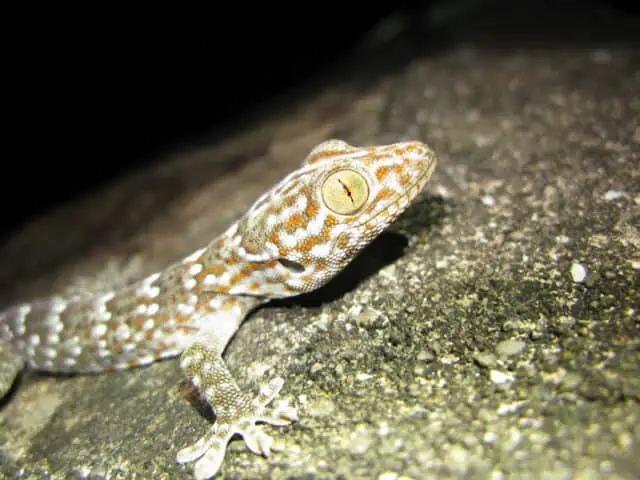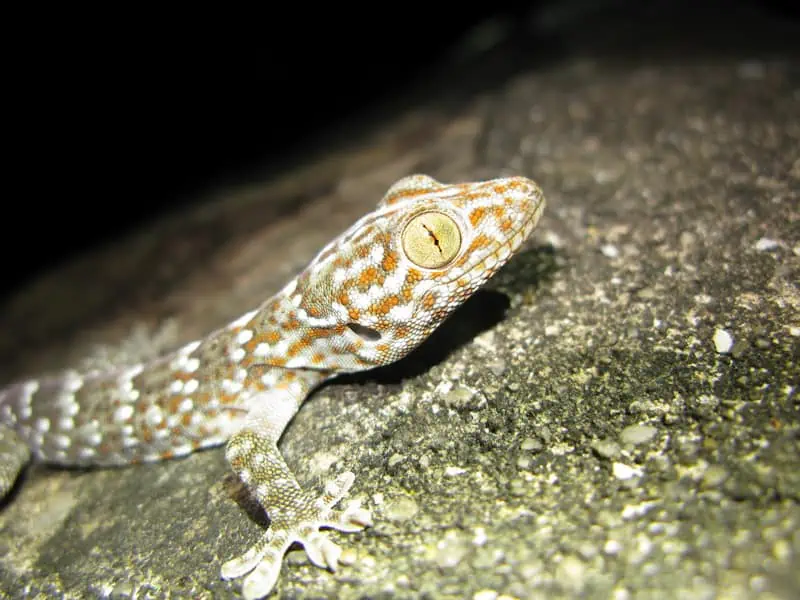Reptile lovers often find themselves drawn to the vibrant colors and curious nature of the Tokay gecko. Native to Southeast Asia, this species is known for its striking appearance, featuring an enchanting blend of blues, grays, and vibrant reds. However, Tokay geckos have earned a reputation for their shy and occasionally elusive behavior.
For new and even experienced gecko owners, it can be perplexing to find their Tokay gecko often hiding away, avoiding interaction. The question “Why is my Tokay gecko hiding?” becomes a common concern, especially when you’re eager to connect and interact with your scaled friend. Understanding why these fascinating creatures prefer the solace of solitude is crucial for their health and happiness.
Why Do Tokay Geckos Hide? – Exploring the Nature and Behavior
Let’s start by acknowledging that hiding is natural behavior for Tokay geckos, and many other reptiles as well. They aren’t trying to frustrate you or play hide-and-seek; they’re just doing what comes instinctively to them. This behavior is deeply rooted in their survival instincts and ties to their wild habits.
In the wild, Tokay geckos are prey for a variety of predators, including larger reptiles, birds, and mammals. Hiding allows them to remain unseen by these potential threats, significantly increasing their chances of survival. Therefore, a certain degree of “shyness” is not only typical but also healthy for these creatures.
However, when we bring a Tokay gecko into our homes, they don’t immediately understand that they are now safe from predators. Those natural instincts don’t just vanish. So, while you might view your home as a safe haven, your gecko might still see potential risks and threats, leading them to seek refuge in hidden spots.
This doesn’t mean they are perpetually terrified. Hiding is also part of their rest and relaxation routine. Tokay geckos are nocturnal creatures, meaning they are most active during the night and tend to sleep or rest during the day. A quiet, secluded spot offers them the darkness and tranquility they need for their sleep cycle.
Understanding these aspects of their nature and behavior can help us empathize with our Tokay geckos and ensure we’re providing a suitable environment that respects their natural instincts and needs.
Signs That Your Tokay Gecko Is Hiding – What to Look Out For
Recognizing that your Tokay gecko is hiding frequently or excessively isn’t always straightforward. After all, these creatures are naturally good at hiding. Here are a few signs that suggest your Tokay gecko might be spending more time hidden than is normal or healthy:
Decreased Activity Levels: If you notice a significant decrease in your gecko’s usual activity, this could be a sign that it’s hiding more often. Keep in mind that Tokay geckos are nocturnal, so “activity” usually means seeing them move around their enclosure during the evening or night.
Changes in Eating Habits: If your gecko is eating less than usual or not eating at all, this could indicate excessive hiding. It’s worth noting, though, that decreased appetite can also be a sign of other health issues, so it’s essential to monitor this closely.
Rarely Visible: A clear sign of frequent hiding is if you rarely see your gecko. While it’s normal for them to hide during the day and come out at night, if you don’t see them even during their active hours, they might be spending too much time hidden.

Factors Influencing a Shy Tokay Gecko:
Understanding the factors that might influence your Tokay gecko’s hiding behavior can help you address the issue effectively. These factors are generally divided into three broad categories:
Health Concerns
Health issues can often lead to a change in behavior, including increased hiding. If your gecko is feeling unwell or is in pain, it may hide more as a natural self-preservation instinct. Look for additional signs of health problems, such as changes in appetite, lethargy, changes in the skin, or difficulty moving. If you suspect your gecko may be sick, it’s crucial to consult a vet who specializes in reptiles for a proper diagnosis and treatment plan.
Environmental Conditions
The environmental conditions of your gecko’s enclosure can also influence its hiding behavior. Remember, these creatures are from tropical environments. They need a specific range of temperature and humidity, as well as plenty of hiding spots, to feel comfortable. An enclosure that’s too cold, too dry, too small, or lacks appropriate hiding places can lead to stress and increased hiding behavior.
Stressors and Threats
Even in captivity, Tokay geckos are sensitive to perceived threats or stressors. These could include other pets, loud noises, too much handling, or even the presence of people if they’re not used to it. A gecko that’s feeling threatened or stressed will likely hide more frequently.
How to Encourage Your Tokay Gecko to Be Less Shy
While recognizing that a certain level of hiding is normal for Tokay geckos, there are ways to make your pet feel safer and potentially less shy. Here, we’ll cover some strategies you can use to make your gecko more comfortable.
Providing an Ideal Habitat
The first step is to ensure that you’re providing an environment that mimics the gecko’s natural habitat as closely as possible. This includes an adequately sized enclosure, with plenty of places for the gecko to hide and climb. Including plants (either real or artificial), rocks, and logs can help create a more naturalistic setting.
The temperature and humidity levels of the enclosure also play a critical role in the comfort of your gecko. The temperature should range between 75-90°F, with a slight drop at night, and humidity should stay around 70-80%. Proper temperature and humidity not only ensure that your gecko remains healthy but also that they feel secure enough to come out of hiding.
Ensuring Proper Diet and Hydration
A well-fed gecko is a happy gecko. Ensure you’re providing a balanced diet suitable for Tokay geckos, typically consisting of a variety of insects such as crickets, mealworms, and roaches. Offering food in the evening when your gecko is more likely to be active can also help reduce its shyness.
Keeping your gecko well-hydrated is also crucial. In addition to providing a water dish, consider misting the enclosure regularly to mimic the gecko’s natural humid environment.
Handling Your Tokay Gecko
Handling can be a contentious topic in the reptile community, especially for a species known for its shyness like the Tokay gecko. However, some argue that regular, gentle handling can help build trust between you and your gecko, making them less prone to hiding.
If you decide to try handling, remember always to be gentle and patient. Start by handling your gecko for short periods and gradually increase the time as they become more comfortable. Avoid any sudden movements that could scare your gecko, and always respect their signals if they seem uncomfortable or stressed.
By providing an ideal habitat, ensuring a proper diet and hydration, and handling your gecko gently and appropriately, you can help encourage your shy Tokay gecko to become more comfortable in its environment and reduce excessive hiding behavior.
When Should You Be Concerned? – Understanding When Hiding Is a Problem
While a certain level of hiding is normal and expected, there are times when it can be a cause for concern. Excessive or prolonged hiding can indicate that your gecko is under stress, feels threatened, or may be unwell.
Here are some signs that hiding might be indicative of a problem:
Changes in eating or drinking habits: If your gecko is eating or drinking less than usual, this might indicate a health issue that needs attention. A loss of appetite can be linked to a variety of health concerns, from stress to metabolic disorders.
Physical signs of illness: If your gecko shows other signs of illness, such as weight loss, lethargy, irregular feces, or visible parasites, it’s essential to seek veterinary advice.
Changes in behavior: Changes in your gecko’s behavior, such as increased aggression, irregular activity patterns, or signs of anxiety and stress, can be a red flag that something isn’t right.
If your gecko is exhibiting any of these signs along with increased hiding, it’s crucial to consult with a reptile-savvy veterinarian as soon as possible. While it’s perfectly natural for a Tokay gecko to enjoy hiding, extreme behavior changes are often a signal that they require help.
Conclusion: Embracing Your Shy Tokay Gecko
Understanding the natural behaviors of your Tokay gecko, including their propensity to hide, is part and parcel of being a responsible and caring owner. Hiding is a natural behavior deeply ingrained in their survival instincts. As pet owners, our goal is to ensure that our geckos feel safe and comfortable in their environment, while respecting their natural tendencies.
If your Tokay gecko tends to be shy, remember it’s not a reflection of your care or a sign that your pet doesn’t like you. It’s simply part of their nature. By understanding the reasons behind this behavior and making any necessary adjustments to their environment or care routine, you can help your gecko feel more secure and content.
However, always keep an eye out for changes in behavior that might indicate a problem. Excessive hiding, especially when paired with other concerning signs, should not be ignored. When in doubt, always consult with a professional.
In the end, being a gecko owner is about embracing and nurturing these unique creatures, shyness and all. They may not show their affection in the same way a dog or a cat would, but the bond you build with your gecko is nonetheless rewarding and unique in its own right.
FAQs
Why is my Tokay gecko always hiding?
Tokay geckos naturally have a tendency to hide due to their survival instincts. They are prey in the wild, so hiding helps protect them from predators. However, if your gecko is always hiding and showing signs of stress or illness, it may be worth consulting a vet.
How can I encourage my shy Tokay gecko to come out more often?
Ensuring that your gecko has a suitable environment can help. This includes providing an adequately sized enclosure, maintaining proper temperature and humidity levels, and ensuring they have plenty of places to hide paradoxically. Also, gentle and gradual handling might help them become more comfortable around you.
Is hiding a sign of illness in Tokay geckos?
While hiding is a natural behavior for Tokay geckos, excessive or prolonged hiding can sometimes indicate stress or illness. If you notice other signs of illness, like changes in eating habits or physical signs of distress, consult with a vet.
Can handling my Tokay gecko help with its shyness?
Regular, gentle handling can potentially help build trust between you and your gecko, making them less prone to hiding. However, it’s important to be patient, respect their signals, and never force interaction.
How long does it take for a Tokay gecko to get used to a new environment?
This varies from gecko to gecko. Some may adjust within a few days, while others might take weeks. Ensure they have plenty of hiding spots in their enclosure to feel safe during this adjustment period.
Should I worry if my Tokay gecko hides all day?
No, this is perfectly normal. Tokay geckos are nocturnal creatures, which means they are most active during the night and sleep or rest during the day. If your gecko hides all day but is active at night, there’s typically no cause for concern.
Do Tokay geckos need hiding spots in their enclosure?
Yes, providing multiple hiding spots is crucial for a Tokay gecko’s enclosure. They help mimic the gecko’s natural environment and provide places where the gecko can rest and feel safe.
Is it okay to check on my Tokay gecko while it’s hiding?
While it’s fine to check on your gecko, avoid disturbing them, especially during their rest period during the day. Continual disturbance can stress your gecko and lead to further hiding.





